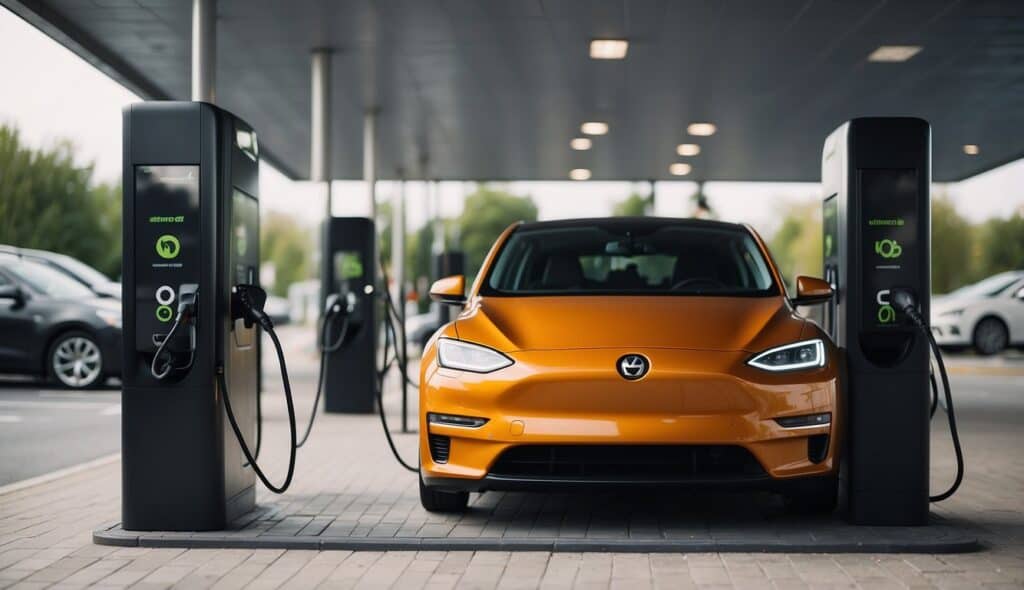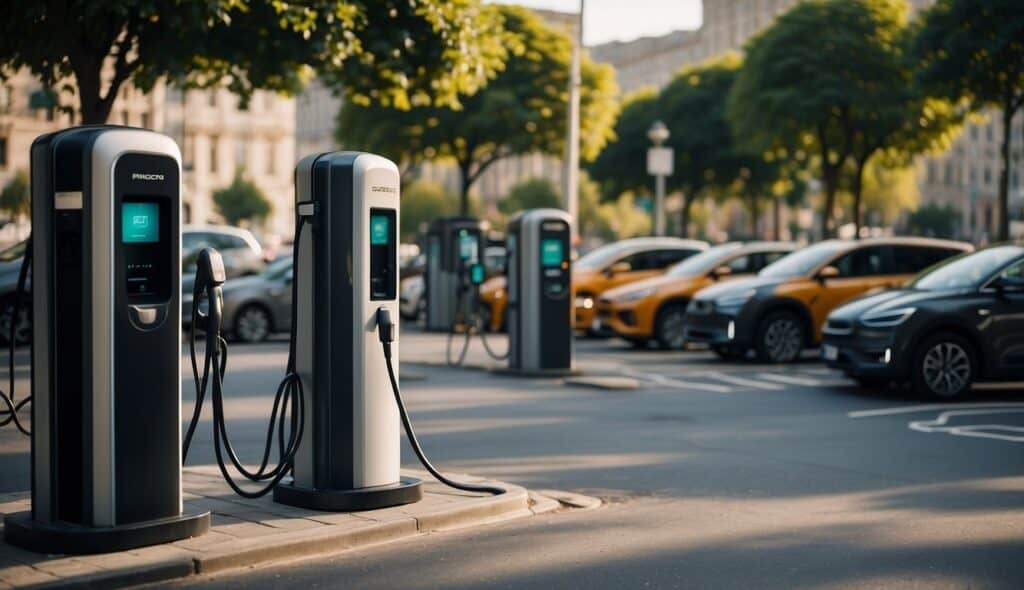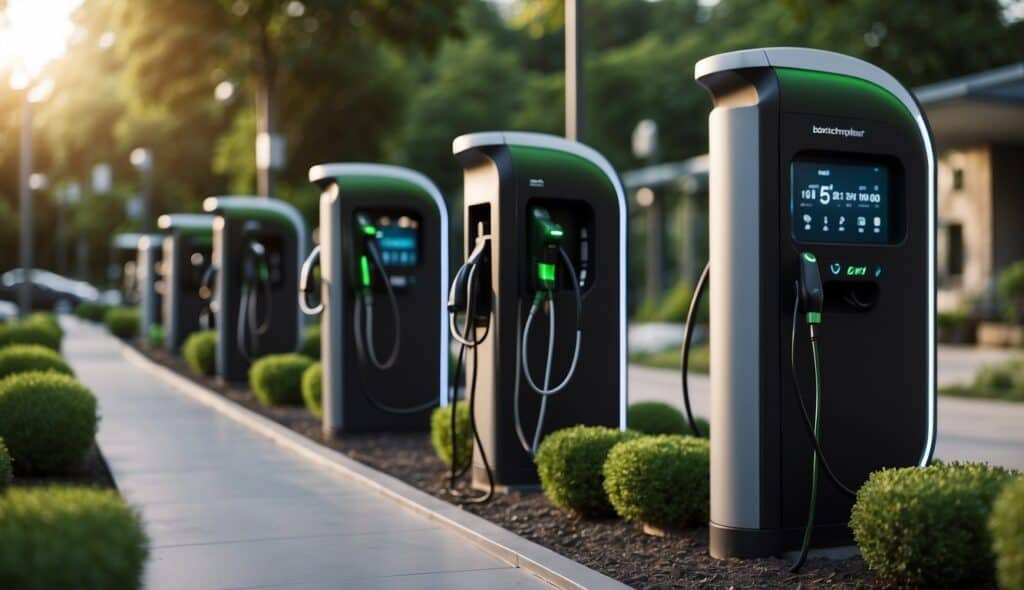Electric vehicle (EV) charging stations present a compelling business opportunity as the world shifts towards renewable energy. Industry experts predict a rapid increase in electric vehicle sales, driving demand for more charging infrastructure. This growing need opens the door for profitable ventures in setting up EV charging stations.
Investing in EV charging stations can be lucrative but requires careful planning. The installation costs for fast chargers can be high, potentially reaching up to $100,000 per unit. Despite these initial expenses, businesses can benefit from tax credits, significantly reducing the effective cost of establishing these stations.
Pairing effective business models with funding opportunities can maximize returns. Potential investors can explore various business models, including subscription services, pay-per-use, or integration with existing businesses, like parking lots and retail spaces.
How is the EV Charging Market
The demand for electric vehicles (EVs) continues to rise, creating new opportunities for businesses to invest in EV charging infrastructure. Key aspects include the growth in EV adoption and the emergence of varied business models in the EV charging sector.
The State of EV Adoption
The electric vehicle market has grown rapidly in recent years. In 2013, only 110,000 battery-powered vehicles were sold globally. By 2022, this number skyrocketed to over seven million, representing 14% of the auto market. This growth is driven by both consumer preference and stricter environmental regulations.
Automakers are increasingly investing in electric models. High consumer demand is evident, with one report noting a significant increase in EV sales from 2020 to 2022. Around 26 million electric vehicles now travel the world’s roads, indicating a strong and growing market for EVs.
Government incentives are also crucial. For example, the Alternative Fuel Infrastructure Tax Credit offers significant financial benefits to businesses installing EV charging stations.
By making such investments, businesses can benefit from tax credits of up to $100,000 per item, further fueling the growth of EV infrastructure.

Emerging Business Models in EV Charging
Businesses have diverse options for entering the EV charging market. Some popular models include pay-per-use charging stations, where users pay each time they charge their vehicle, and subscription models, offering unlimited charging for a monthly fee. Each model comes with its advantages, catering to different consumer needs.
Choosing the right charging equipment is essential. The most common connector types include the SAE J1772, known as the J Plug, supporting Level 1 and 2 charging systems widely used in North America, and the IEC 62196 Type 2, the European standard for Level 2 chargers.
Profitability in the EV charging business is evident as more drivers switch to electric cars, increasing the demand for accessible charging points. Businesses can capitalize on this trend by selecting the appropriate model and equipment and aligning their operations with growing consumer demand.
Check out Why Can’t an Electric Car Charge Itself While Driving?
Planning Your EV Charging Station Business
Choosing the right location, catering to customer needs, and understanding the competition are crucial steps in planning an EV charging station business. These factors can significantly influence the venture’s success and profitability.
Location and Visibility
Selecting a high-traffic location is essential. EV charging stations should be placed in areas with a lot of activity, such as shopping malls, near highways, and busy town centers. These locations ensure that your charging station is visible and accessible to many potential customers.
Additionally, partnering with local businesses can create mutual benefits. Retailers like grocery stores or restaurants can provide added convenience to drivers who may spend more time at these places while their vehicles charge. Prominent signage and easy access from main roads can further enhance visibility.
Assessing Customer Needs and Convenience
Understanding the needs of EV owners is vital. Customers look for reliable and fast service. Offering a mix of Level 2 and Level 3 chargers can cater to different charging needs. Level 3 chargers, also known as fast chargers, can quickly top off a car battery, making them a preferred choice for many drivers.
Convenient payment options are also important. Setting up multiple payment methods, including mobile payments, contactless credit cards, and dedicated apps, can provide a seamless user experience. Availability of amenities such as Wi-Fi, a waiting area, or even vending machines can make the charging time more pleasant for users.
Competitor Analysis and Market Gap
Conducting a thorough competitor analysis helps identify market gaps. Studying existing charging stations in the area and their offerings, rates, locations, and customer reviews can give valuable insights. If competitors lack certain services like high-speed charging or don’t offer facilities such as nearby retail access, those are opportunities for differentiation.
Market surveys and community feedback can further reveal unmet needs. Aiming for areas with limited existing infrastructure or specific demands, like neighborhoods with high EV adoption but few chargers, can provide an advantage. Positioning your business to fill these gaps effectively can set it apart from competitors.
Focusing on these aspects ensures that an EV charging station meets customer expectations and stands out in the market.
Check out Do All Electric Cars Use the Same Charger?
Government Policies and Incentives
Government policies play a crucial role in making electric car charging stations a lucrative business opportunity. Various incentives, subsidies, and tax credits are available to encourage investment in this sector.

Federal and Local Subsidies
The Biden-Harris Administration has opened applications for $1.3 billion in funding for electric vehicle (EV) charging infrastructure. This initiative aims to expand EV charging across urban and rural communities and along major roadways.
Subsidies are available at both federal and local levels. Local governments often offer grants and rebates to businesses that install charging stations. These subsidies can significantly reduce the initial investment cost, making it easier for businesses to enter the market.
In addition to national initiatives, states have their own programs. For example, California provides substantial grants and incentives for installing charging stations in certain areas. These combined efforts aim to create a nationwide network of charging stations, supporting the growth of EVs.
Tax Credits and Funding
The federal government offers various tax credits to promote the installation of EV charging stations. The Federal Alternative Fuel Infrastructure Tax Credit allows businesses to claim up to 30% of the installation costs, which can be significant financial relief for businesses looking to invest in this infrastructure.
Moreover, the Bipartisan Infrastructure Law includes a $7.5 billion investment to enhance the EV charging network. This funding supports not only expansion but also reliability, ensuring that charging stations are operational and accessible.
Additional federal funding is also available through the U.S. Department of Transportation to aid businesses in upgrading and maintaining charging infrastructure. These financial incentives are designed to create a favorable economic environment for EV charging station businesses.
Check out Should I Charge My Electric Car Every Night?
Economic Viability and Profitability
Electric car charging stations present a mix of high upfront costs and multiple potential revenue streams. Key factors in determining profitability include the cost of fast charging units, installation expenses, and how effectively owners can generate income.
Analyzing Costs and Revenue Streams
Initial costs for setting up electric car charging stations are substantial. A 150 to 350kW fast charger can cost between $45,000 and $100,000. Installation costs add another $40,000 to $150,000. Grid upgrades may push costs into the millions. Despite these high expenses, there’s potential for substantial revenue.
Revenue primarily comes from charging fees. Some stations may also earn through partnerships with retail locations, offering chargers to attract customers. These factors can create a reliable income stream.
Setting competitive and profitable electricity prices is crucial. Stations must balance covering high operating costs with attracting customers. If well-managed, these stations can become profitable, despite the significant initial investment.
The Role of Fast Charging in Revenue
Fast charging options are essential for attracting EV owners, especially those traveling long distances. Fast charging units offer a higher rate of return because they can charge vehicles quicker, allowing more customers to use the service in a day. This increases potential revenue.
Tesla’s fast charging stations, known as Superchargers, are examples of this model. They help provide a convenient and quick charging solution, making it a profitable venture. Fast chargers may not be heavily used at night when electricity costs are lower, but the higher daytime usage compensates for this.
Investing in fast charging technology can turn these stations into profitable businesses. The ability to quickly serve more customers can offset the high installation and maintenance costs.
Exploring Passive Income Opportunities
Charging stations can generate passive income through various methods. Some businesses place chargers strategically where customers spend time and money, like shopping centers or restaurants. These locations might share some of their increased customer traffic as part of the revenue stream.
Advertising at charging stations represents another passive income opportunity. Displaying ads on screens or digital kiosks can provide another revenue stream without extra effort from the station owners.
Revenue can also be derived from charging networks. Joining a network that offers user subscriptions can provide consistent monthly income. These passive income opportunities can make electric car charging stations more financially viable.
Check out How Much Does It Cost to Charge an Electric Car at Walmart?
Technical Aspects of EV Charging Stations
Electric vehicle (EV) charging stations come with various technical components that ensure efficient and safe recharging. These technical aspects involve hardware types, charging speeds, power outputs, and adherence to safety standards.

Charging Station Hardware and Types
EV charging stations are primarily categorized into three levels. Level 1 chargers use a standard 120-volt outlet and are suitable for home use, providing around 2-5 miles of range per hour of charging. Level 2 chargers operate on 240 volts and are more common in commercial settings, charging at a rate of 10-20 miles per hour.
Finally, Level 3 chargers, also known as DC Fast Chargers, offer the fastest charging speeds, using 480 volts or more to provide up to 80% charge in 20-30 minutes.
Important hardware components include connector types like the SAE J1772, which is standard in North America, and the CCS (Combined Charging System) used for fast charging.
Charging Speed and Power Output
Charging speed is a crucial aspect of EV charging stations. The speed at which an electric vehicle charges depends on the power output of the charger. Level 1 chargers typically provide 1.4 kW of power, while Level 2 chargers can deliver between 3.3 kW and 19.2 kW. Level 3 chargers or DC Fast Chargers offer power outputs ranging from 50 kW to 350 kW.
Charging network design plays a significant role in managing the power load efficiently. High-power charging stations, like DCFC units, reduce wait times and increase user convenience. As a result, they are more appealing in locations needing quick turnover, such as highway rest stops and urban areas.
Safety and Compliance Measures
Safety is paramount when installing and operating EV charging stations. These stations must comply with various standards to protect users and equipment. Regulations often require rigorous testing and certification for components like cables, connectors, and the overall system.
Essential safety features include ground fault circuit interrupters (GFCIs) and automatic shutoff mechanisms to prevent overcharging or overheating. Obtaining proper permits is critical during the installation phase to ensure that the station meets local and national electrical codes.
Compliance with standards such as UL (Underwriters Laboratories) and IEC (International Electrotechnical Commission) helps maintain safety and reliability in the charging network.
Check out Electric Vehicle Charging Business Model
Operational Considerations
Running an EV charging station involves several operational aspects, including installation and maintenance costs, the utilization of the charging stations, and customer service.
Installation and Maintenance Costs
Installing EV charging stations requires a significant initial investment. Costs vary depending on the type of chargers (Level 2 or DC fast chargers), location, and whether any electrical upgrades are necessary. Simple Level 2 chargers can cost between $2,000 and $5,000 each, while DC fast chargers may range from $20,000 to $50,000.
Maintenance costs, including routine inspections, software updates, and potential repairs, also need consideration. Neglecting maintenance can lead to malfunctions, disrupting service and reducing customer satisfaction. It’s also important to consider any fees associated with utilizing charging networks or platforms, which can impact profitability.
Charging Station Utilization
Utilization rates are crucial for profitability. High utilization means more revenue from charging fees. Factors affecting utilization include station location, availability, and types of chargers installed. Placing chargers in high-traffic areas like shopping centers or near highways can boost usage.
Different chargers serve different needs. For instance, DC fast chargers are ideal for short stops, while Level 2 chargers work well in workplaces where cars stay longer. Monitoring and analyzing utilization data helps optimize station placement and determine when additional chargers are needed, ensuring efficient operation.
Customer Service and Experience
Excellent customer service can set an EV charging station apart from competitors. This includes having a reliable network, quick issue resolution, and user-friendly interfaces. Providing clear signage and real-time information on charger availability can also improve the customer experience.
Extras like covered charging spots, rest areas, or Wi-Fi access can enhance convenience. Additionally, integrating multiple payment options and having a responsive support team can address customers’ problems. Strong customer service can lead to repeat business and positive word-of-mouth referrals.
In summary, effective operational management, including keeping costs in check, ensuring high utilization, and providing excellent customer service, is key to the success of an EV charging station business.
Check out Can You Charge an Electric Car in the Rain?
Collaboration and Partnerships
Collaborations and partnerships are crucial for the success of electric car charging stations. These collaborations involve utility companies, retail and property owners, and automakers, each playing a significant role.
Utility Companies and Power Management
Utility companies are key players in managing the electricity needed for charging stations. They help ensure a stable power supply and work on managing electricity prices. This collaboration can improve power management and grid efficiency, directly impacting operational costs.
Charging station operators can benefit from load management programs by partnering with utility companies. These programs help balance electricity demand and avoid peak pricing. Utility companies can also offer incentives and special rates for off-peak charging, making it more cost-effective.
Alliances with Retail and Property Owners
Retail and property owners can provide prime locations for charging stations. These locations offer convenience for EV owners who can charge their vehicles while shopping or conducting business. Partnering with retail chains and property owners can lead to increased foot traffic and customer loyalty.
Retailers like shopping malls and grocery stores benefit by attracting EV owners looking for charging options. Property owners, including commercial real estate, can monetize unused parking spaces. This partnership benefits both parties in terms of increased revenue and customer engagement.
Cooperation with Automakers
Automakers play a vital role in the EV charging ecosystem. Partnering with automakers ensures that charging stations are compatible with a wide range of vehicles. These partnerships can lead to co-branded charging solutions and integrated services.
Automakers like Tesla and BMW often collaborate with charging networks to develop exclusive charging stations. This cooperation helps provide EV owners with a seamless and reliable charging experience. Automakers can also offer incentives to customers who choose specific charging networks, further boosting the usage of these stations.
Effective cooperation with automakers, utility companies, and retail property owners strengthens the overall EV charging infrastructure, supports network expansion, and ensures a reliable customer experience, enhancing the overall success of charging stations.
Check out Where Can I Charge My Electric Car for Free?
Marketing Strategies for EV Charging Stations
Effective strategies for marketing EV charging stations include strong branding and positioning alongside a robust digital presence, ensuring maximum visibility and ease of access for customers.
Branding and Positioning
Branding is crucial in creating a strong image for EV charging stations. Stations can stand out in a growing market by developing a unique and recognizable brand. Station operators need to create a consistent branding strategy highlighting the benefits of using their services, such as reliability and convenience.
Positioning the stations in visible locations like shopping centers and highways can attract more customers. Stations must convey an image of being modern and eco-friendly, appealing to the values of electric vehicle owners.
Marketing materials should emphasize the service’s unique selling points, perhaps through successful case studies or testimonials. Partnering with automotive manufacturers and local businesses can enhance the station’s visibility and credibility.
Digital Presence and Navigation Inclusion
A strong digital presence is vital for EV charging stations. Creating and maintaining a user-friendly website that provides essential information such as charging rates, station locations, and availability is imperative. Ensuring this information is readily available can significantly enhance the customer experience.
Incorporating EV charging stations into Google Maps and other navigation sites allows drivers to easily locate and navigate to the nearest station. This visibility on popular navigation tools can drive traffic and boost usage rates. Additionally, creating listings on EV-specific navigation apps can provide targeted visibility.
Regular updates on social media platforms about promotions, new station openings, and customer testimonials can help maintain customer engagement. This active digital presence encourages customer loyalty and brand recognition.
Sustainability and Future Outlook
Electric vehicle (EV) charging stations offer a significant long-term business opportunity due to their environmental benefits and technological advancements. This section explores how integrating renewable energy solutions and analyzing current trends can impact the future of EV infrastructure.
Integrating Renewable Energy Solutions
Integrating renewable energy sources such as solar panels can enhance the sustainability of EV charging stations. Solar panels reduce reliance on non-renewable energy and help lower operational costs. Additionally, they can provide businesses with a sustainable energy model, reducing the environmental impact associated with traditional energy usage.
Battery storage systems are another essential component. They store excess energy generated during the day and use it during peak hours, optimizing energy usage. This approach not only cuts costs but also ensures a reliable energy supply, boosting the efficiency of EV infrastructure.
Trends and Predictions in EV Charging Infrastructure
The growth of EV charging infrastructure has been remarkable. The public charging stock increased by more than 40% in 2023. Due to their efficiency, fast chargers, which now make up 55% of all new installations, are becoming more popular.
China leads the global deployment of electric vehicle supply equipment (EVSE), claiming over 85% of the world’s public charging points. Predictions indicate that by 2030, public charging points worldwide will exceed 15 million. By 2035, this figure could reach up to 25 million, reflecting a sixfold increase from 2023 levels.
This expansion presents vast opportunities for businesses to invest and grow within the EV charging sector. The increasing number of EVs on the road demands more accessible and efficient charging solutions, making it a key area for future investments.
Conclusion
Electric car charging stations present a significant business opportunity. The rise in electric vehicle (EV) adoption means there is a growing need for convenient and accessible charging options.
The U.S. Department of Transportation’s NEVI program aims to deploy a national network of EV charging stations, helping to ease concerns about charging availability on major highways.
Starting an EV charging business requires choosing the right connector types. For example, U.S. stations might use the SAE J1772 connector, which supports Level 1 and 2 charging.
Entrepreneurs should consider costs and profit margins. Details on costs and profit margins can provide insights into financial planning.
Tax incentives like the Alternative Fuel Infrastructure Tax Credit can make the venture more attractive. Eligibility for this credit means businesses can get a portion of their costs covered, up to $100,000 per item, when they install charging stations between 2023 and 2032.
Focusing on sustainable transportation, this business contributes to environmental goals and taps into a growing market. Entrepreneurs can benefit from financial returns and the chance to support the green revolution.

Hi, I’m Marybeth, an electric car enthusiast living in New York in the USA. As the owner of electriccartalks.com, I love sharing my knowledge on EV tips, battery maintenance, and charging solutions. As a proud Tesla owner, I blend my personal experiences with professional insights to offer valuable information to fellow EV enthusiasts. Through my articles, I aim to empower others to make informed decisions about their electric vehicles. Read more